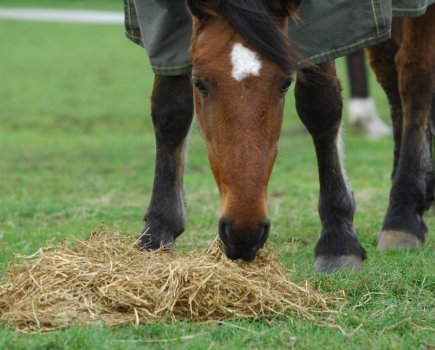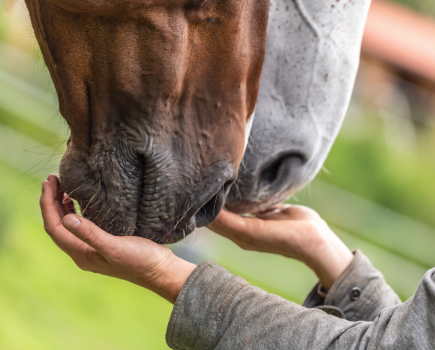Advertisement feature
What does it take for received wisdom to be overturned and new approaches adopted? Revelatory research findings? Social demand for change?
Both could actually result in a change to the way horses are fed today, as researchers find ways to feed and manage horses more sympathetically and sustainably.
The horse is a herbivore and as soon as we prevent them eating and accessing a natural diet as they have evolved to do, there are repercussions for their health and well-being.
The increasing frequency with which gastric ulcers is being diagnosed may account for why the recommendations for the minimal amount of forage a horse requires has increased in recent years.
Evolutionary considerations for sympathetic feeding
Rendle et al. (2020) cite 1.5% of bodyweight on a dry matter basis, which is the level most equine nutritionists would advocate for the long-term health of the horse.
The glandular region of the horse’s stomach contains glands that secrete acid continuously, as the horse is a trickle feeder and it is important to note that this process continues even when the horse isn’t eating.
This is why periods of more than six hours without access to forage are a risk factor for ulcers. The volume of secretion has been shown to be around 1.5 litres of gastric juice per hour, although this does vary at different times during the day.
Consuming too little fibre and eating materials that are high in starch, means acidity levels increase in the stomach. This not only increases the risk of ulcers, but also changes the environment in the stomach sufficiently to impact the microbes that live there.
Microbial dysbiosis in the stomach is increasingly being linked to an increased risk of gastric disease, particularly in the glandular region, which is now recognised as an inflammatory disease rather than an ulcerative one.
Alfalfa as an energy source: the research
So can fibre be fed to fuel performance? Researchers at the Lab to Field research centre in Dijon, France, believe so.
In work funded by the French government and published in Frontiers in Physiology, they found that Standardbred horses in training fed a third of their total ration as alfalfa with just 7% oats, performed comparably with those fed 33% oats. (The remainder of the diet was hay.)
The horses were monitored over an eight-week period rather than just in a one-off standardised exercise test (SET). The replacement of a significant proportion of oats with alfalfa had no detrimental effects on performance or muscle tone.
In fact, alfalfa altered energy metabolism in such a way as to potentially improve performance and recovery according to the authors (Martin et al., 2023).
Counteracting stomach acid
Studies back in the early 2000s (Nadeua et al, 2000; Lybbert et al, 2007) showed that alfalfa was more beneficial for horses with ulcers compared to grass forages because it helps counter the increased acidity that occurs when feeding cereals.
This latest study suggests that alfalfa can actually replace a significant proportion of cereal as an energy source too.
The prevalence of gastric ulcers means it is an issue that needs to be addressed, especially when viewed in the context of equine welfare in sport.
Two recent studies have again shown how alfalfa has a key role to play in this regard too. The Lab to Field research group demonstrated that clinical success with horses with EGGD was 47.7 times more likely in horses fed alfalfa pellets as part of their ration compared to those on concentrate only rations (Julliand et al., 2023).
Fibre quality
In addition, a study published in 2024 showed that a combination of alfalfa, sugar beet and cereal fibre fed alongside the existing ration, aided the reduction in recurrence of gastric ulcers when fed during the healing and post-medication periods.
This is key for when gastric ulcer medication is stopped and the recognised rebound increase in acid production can occur (Menzies-Gow and Shurlock, 2024).
A key point from these studies is that the quality of fibre matters. Alfalfa and sugar beet both contain higher proportions of digestible fibre such as pectin and hemi-cellulose, rather than indigestible fibrous elements such as lignin.
This means they aren’t sitting in the gut for so long, but they are being digested and utilised as an energy source.
What is alfalfa?
Alfalfa (Medicago sativa), also known as lucerne, has been cultivated as horse feed for over 2000 years. It originated from Iran before spreading across the world as Persians, Greeks and Romans expanded their empires, bringing their horses and their feed with them.
Alfalfa is a legume and from the same plant family as peas, beans and clover. It has a deep root system that enables it to access water and minerals deep in the soil.
In some cases, alfalfa roots can reach 4 or 5 metres deep, in comparison to grass and cereals which have roots of about 2-2.5m.
Rich in calcium
Alfalfa’s deep roots mean it can reach calcium which at this depth in the soil is more available for absorption. This means that alfalfa plants can take up more calcium than grass. In fact, chopped alfalfa contains between 30 and 50% more calcium than grass forages.
This has real benefits for gastric health as it is one of the qualities that means alfalfa is a natural buffer to acidity in the horse’s stomach.
Early studies suggest that omeprazole — the medication used to treat gastric ulcers — is reducing calcium absorption in the horse as is seen in humans.
Researchers are suggesting that bio-available calcium sources should be added to the diet to counteract this effect.
TOP TIP!
Feed a double handful of a chopped alfalfa-based fibre feed around 20-25 minutes before you ride to help prevent ‘acid splash’ in the non-glandular region of your horse’s stomach. The fibre makes sure the stomach isn’t empty and suppresses the movement of the acidic contents when the horse moves.
Feeding chopped fibre matters
There are some fundamentals of feeding that stand the test of time and adding chopped fibre to a horse’s bucket feed is one of them.
The following video explains why you should add chaff to your horse’s bucket feed:
The benefits of increased chew time from adding a chopped fibre to the bucket feed has long been recognised, but what is often over-looked is that the amount of saliva produced when a horse chews is related to the amount of force the horse needs to apply (Vervuert, 2012).
So more fibrous materials help to increase saliva production and therefore more natural buffering in the digestive tract than softer ones.
Whilst mashes and pelleted fibres contribute fibre, they don’t require as much chewing and so do not generate as much saliva.
This phenomenon is supported by a very recent study that found unmolassed sugar beet pulp mash resulted in a greater drop in pH (increase in acidity) in the horse’s mouth than other feed materials including alfalfa and haylage. The authors suggest this could be related to the fact it requires less chewing (Daniels et al, 2024).
Whilst the level of acidity returned to normal within 15 minutes and so doesn’t represent a cause for concern in the context of dental health, it demonstrates the importance of chewing for saliva production, which has benefits further along the digestive tract.
Energy without starch
Like other plants, alfalfa makes sugar when photosynthesising but if it makes more sugar than it needs, it stores any surplus as starch in its roots — and this is the part that horses don’t eat!
This is in contrast to grass, which stores sugar as water soluble carbohydrates such as fructan in stems and leaves.
When oil is added as a coating to alfalfa horse feeds, sugar levels are typically less than 5% but the energy is high enough to support horses in moderate to hard work.
Feeds are rarely, if ever, sugar free, as even straw contains some sugar which is why we use the phrase “no added sugar” to describe our lowest sugar feeds.
Feeding Alfa-A Oil
Combining alfalfa with oil, such as in Alfa-A Oil, produces a feed with 12.5MJ DE per kg, which is equivalent to a conditioning mix but with 10 times less starch.
‘My horses have never felt better’
Alfa-A Oil has been used for many years by top-level event rider Alex Bragg, who had a career best season in 2024, finishing third at Badminton and eighth at Burghley on the Roe family’s beautiful mare Quindiva.
“Dengie Alfa-A Oil is an essential element of all of our horses’ diets,” says Alex. “Its combination of pure alfalfa and oil provides the ultimate blend of slow-release energy and helps them maintain condition.
“We know a healthy, happy horse can give 100% in both training and competition. My horses have never performed, looked or felt better.”
In this webinar, Alex chats about his most successful season to date.

‘It’s a long-term feeding plan’
Lewis Robertson-Carrier is an international dressage rider and trainer. He was crowned British Dressage national champion riding Diego V in 2024.
“I have fed Dengie for as many years as I can remember,” says Lewis. “Ensuring the horses receive quality fibre to support gastric health has always been my priority, and Dengie feeds offer just that.
“The slow-release energy that comes from the fibre suits my horses from the start of their careers right through to top international level, so all the horses are catered for with a long-term plan in place.
“Being BETA NOPS approved is also hugely important and gives me peace of mind that Dengie takes contamination and clean sport as seriously as we have to as athletes.”

‘I wouldn’t feed anything else’
International dressage rider and trainer Hannah Esberger-Hancock says Alfa-A Oil is “perfect” for her dressage horses.
“The alfalfa fibre supports gastric health and I’m confident that they are getting all the energy they need to perform at the top level,” she explains.
“I wouldn’t feed anything else.”


For further information on feeding alfalfa or to speak to a qualified nutritionist call 01621 841188 or complete Dengie’s Feed Advice Form.










